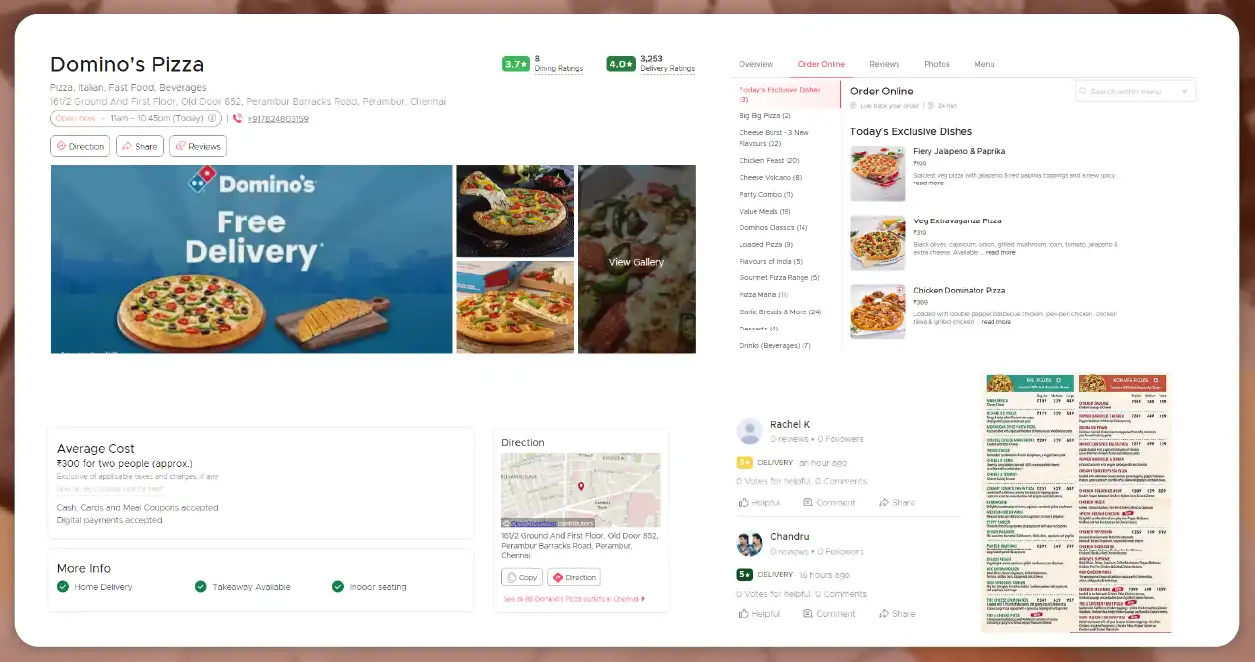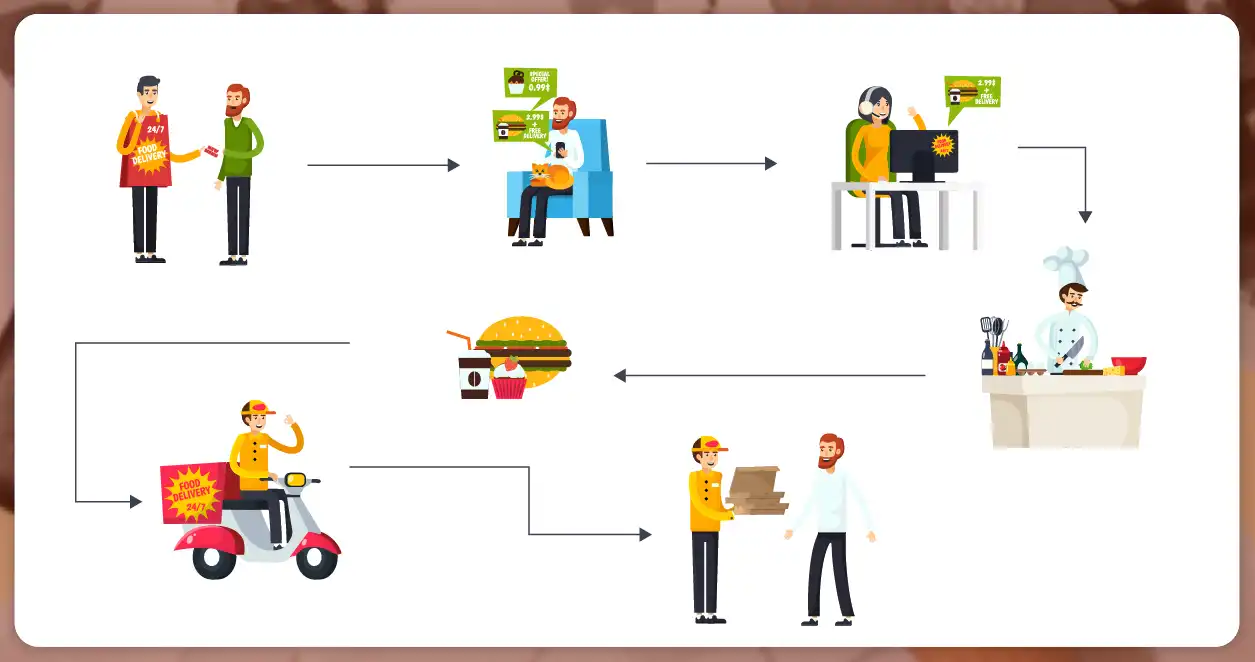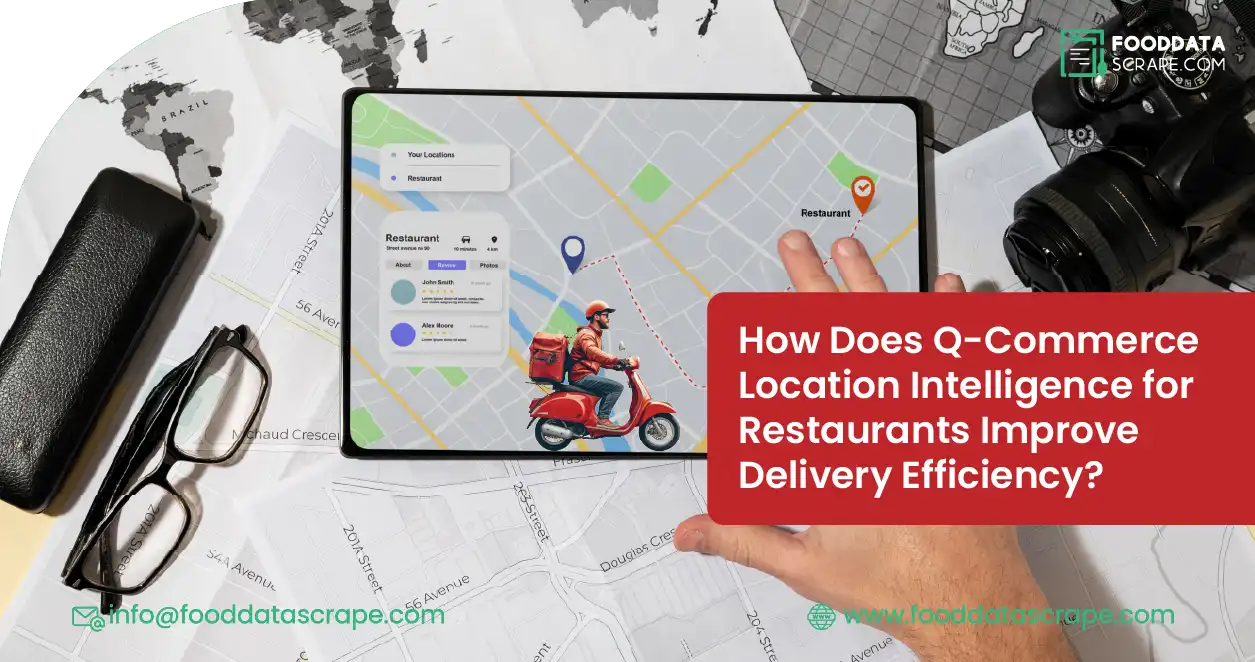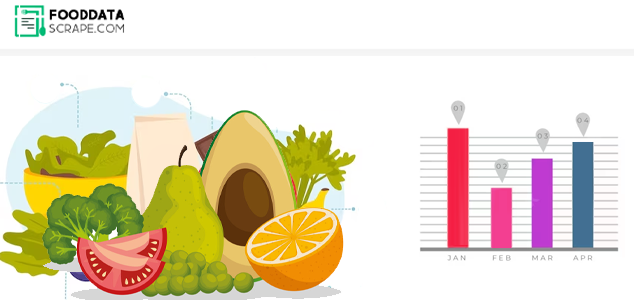Introduction
With the era of hyper-speed business and instant consumer decisions, quick commerce (Q-Commerce) has become a revolutionary power in the restaurant and food delivery sector. With increasingly hectic lifestyles in cities, the need for instant access to essential items and food has driven the growth of Q-Commerce, prioritizing speed and convenience, even with promises to deliver orders between 10 and 30 minutes.
Behind the scenes of this dynamic environment is an enormous amount of data created by restaurants, delivery platforms, and consumer interactions. Q-Commerce Location Intelligence for Restaurants is becoming increasingly vital for businesses wanting to capitalize on this data to streamline operations and improve customer experience. Companies receive actionable insights into market reach and delivery efficiency by employing sophisticated methods to Extract Q-Commerce Restaurant Coverage Data. Furthermore, Web Scraping Restaurant Delivery Zones for Q-Commerce allows service areas to be mapped with accuracy, assisting companies in driving growth and sustaining competitive advantage within the fast-changing industry.
What is Q-Commerce Restaurant Data?

Q-Commerce restaurant data encompasses all information related to quick commerce food outlets, including but not limited to:
- Real-time and historical menu offerings
- Pricing variations
- Customer reviews and ratings
- Delivery times and areas served
- Popular dishes and consumer ordering patterns
- Restaurant operational hours and availability
- Promotions and discounts specific to locations
Such data is often aggregated from multiple sources, including food delivery apps, aggregator platforms, restaurant websites, and social media channels. The richness of this dataset provides a detailed lens through which businesses can analyze consumer behavior and operational performance in the fast-moving Q-Commerce space.
The Role of Location Intelligence in Q-Commerce

Location intelligence is the strategic use of geographic data to drive better decision-making. In the context of Q-Commerce restaurants, it helps businesses understand where demand exists, optimize delivery routes, tailor offerings to local preferences, and predict market trends. Extract Q-Commerce Restaurant Data for Location Intelligence by providing precise geographic details to enable these insights.
The fast delivery promise of Q-Commerce means that proximity and geography play a critical role. Scraping Q-Commerce Restaurant Delivery Locations helps gather the necessary data to map demand and optimize logistics effectively. Knowing exactly where customers are, which locations have the highest demand, and how delivery times correlate with distance allows businesses to:
- Enhance delivery efficiency by positioning inventory and staff optimally.
- Customize menus and pricing to fit local tastes and economic conditions.
Scrape Restaurant Delivery Locations for Q-Commerce to provide granular location data that supports targeted marketing and operational adjustments.
- Identify new areas for expansion based on unmet demand.
- Monitor competitors’ presence and promotional strategies geographically.
By leveraging location intelligence, companies in the Q-Commerce ecosystem gain a decisive competitive edge.
Enhancing Customer Experience Through Location-Specific Insights

One of the core benefits of extracting Q-Commerce restaurant data lies in its ability to elevate the customer experience by delivering hyper-localized services. The convenience of fast delivery goes beyond speed — customers increasingly expect relevant, personalized choices influenced by their location.
For example, analyzing ordering patterns in different neighborhoods can reveal local favorites or emerging food trends, enabling restaurants to adjust their menus dynamically. A coastal area might show high demand for seafood dishes, while a tech hub might lean toward quick vegan or health-conscious options. Having this insight allows Q-Commerce operators to:
- Curate location-specific menus that resonate with local tastes.
- Offer targeted promotions and discounts to increase order frequency.
- Anticipate peak order times based on historical data tied to local events or seasons.
- Ensure the availability of popular dishes based on real-time demand metrics.
Personalization, empowered by location intelligence, drives loyalty, boosts satisfaction, and fosters repeat business in a competitive market.
Optimizing Supply Chain and Inventory Management

Q-Commerce’s promise of ultra-fast delivery demands a finely tuned supply chain that responds instantly to fluctuating demand. Extracting restaurant data connected to geographic zones enables more accurate demand forecasting and inventory management. By understanding which dishes or ingredients are most popular in specific areas, restaurants can:
- Stock the right quantities of perishable goods closer to high-demand zones, reducing waste and spoilage.
- Coordinate with suppliers and fulfillment centers to replenish inventory swiftly.
- Streamline kitchen operations by preparing menu items tailored to local preferences.
- Avoid stockouts that can lead to customer dissatisfaction or missed sales opportunities.
Such precision not only cuts operational costs but also enhances the sustainability of food delivery services by minimizing waste, a growing concern among conscious consumers.
Competitive Benchmarking and Market Analysis

Staying ahead of competitors requires continuous market intelligence in the rapidly evolving Q-Commerce landscape. Extracting restaurant data geographically enables businesses to benchmark their offerings and performance against local competitors, revealing strengths and areas for improvement.
Location intelligence supports the identification of:
- Market saturation points and underserved neighborhoods ripe for entry.
- Pricing strategies and promotional activities employed by rivals within specific geographies.
- Consumer sentiment trends through aggregated reviews and feedback analysis.
- Seasonal or event-driven demand fluctuations across different regions.
With this knowledge, Q-Commerce players can refine their competitive strategies, launch targeted marketing campaigns, and identify partnership opportunities that leverage complementary strengths.
Strategic Expansion and Site Selection

For restaurant chains and delivery platforms looking to expand, data-driven site selection is critical. Traditional methods often relied on intuition or basic demographic data, but extracting granular Q-Commerce restaurant data combined with location intelligence transforms the decision-making process.
Key insights that drive expansion include:
- Identifying gaps in delivery coverage where consumer demand outstrips supply.
- Understanding the delivery radius effectiveness and optimizing “dark kitchen” placement.
- Evaluating neighborhood demographics, purchasing power, and lifestyle compatibility.
- Assessing competitors’ physical and digital presence to avoid oversaturation.
This data-driven approach mitigates risks and increases the likelihood of successful new outlets or kitchens, ensuring that investment aligns with market potential.
Real-Time Operational Decision-Making

Q-Commerce thrives on speed and adaptability. Making real-time decisions based on extracted restaurant data enhances operational agility. Location intelligence provides contextual information necessary for:
- Dynamically adjusting delivery zones during peak hours or adverse weather.
- Rerouting orders in case of traffic disruptions or temporary closures.
- Deploying additional staff or delivery riders to high-demand areas.
- Scaling back services temporarily in low-demand zones to optimize resource allocation.
Such flexibility directly impacts customer satisfaction and profitability, reinforcing a brand’s reputation for reliability and responsiveness.
Unlock the power of location intelligence today—transform your Q-Commerce strategy with precise restaurant data!
Informing Marketing and Loyalty Programs

Marketing efforts gain significantly from the granular insights derived from Q-Commerce restaurant data linked to locations. Leveraging Food Delivery Scraping API Services allows marketers to access real-time, location-specific data to fine-tune their targeting strategies. Businesses can craft campaigns that resonate more effectively by targeting:
- Neighborhood-specific preferences and popular cuisines.
- High-frequency orderers with personalized offers.
Using Restaurant Data Intelligence Services analyzes customer behaviors and regional trends to maximize campaign impact.
- Seasonal or event-driven demand patterns.
- Geographically relevant influencer collaborations or local partnerships.
Moreover, loyalty programs can be tailored to reward behaviors that align with business goals in specific regions — for instance, encouraging repeat orders during off-peak hours or upselling complementary menu items popular in certain areas.
Empowering Data-Driven Innovation

Beyond immediate operational benefits, extracted Q-Commerce restaurant data fuels innovation. Scrape Q-Commerce Restaurant Locations Data to identify ideal zones for targeted business experiments and strategic growth. Location intelligence offers a foundation for experimenting with new business models, such as:
- Launching hyper-localized virtual brands that serve niche tastes.
- Testing novel delivery concepts, like drone or robot delivery, in ideal zones.
Partnering with reliable Food Delivery Data Scraping Services ensures continuous access to fresh, actionable data for informed decision-making.
- Creating AI-driven predictive models that anticipate demand surges or ingredient shortages.
- Collaborating with local producers to source region-specific ingredients.
Integrating insights from Restaurant Menu Data Scraping allows businesses to tailor offerings precisely to evolving customer preferences. The insights harvested from data empower stakeholders to iterate, adapt, and stay ahead in a fast-changing marketplace.
How Food Data Scrape Can Help You?
- Real-Time Competitive Pricing Insights: Gain immediate access to live pricing data from platforms like Instacart and Walmart, which will help you adjust your pricing strategies to stay ahead of the competition.
- Customized Discount Alerts & Deal Monitoring: Automatically track flash sales, rollbacks, and category-specific discounts to optimize procurement, marketing, and promotional campaigns.
- Enhanced Product Trend Analysis: Leverage scraped data to monitor product popularity, seasonal demand, and consumer behavior trends, enabling smarter inventory and merchandising decisions.
- Location-Based Intelligence for Q-Commerce: Integrate geographic data with our scraping capabilities to uncover delivery zones, restaurant availability, and regional pricing differences for strategic market expansion.
- Actionable Dashboards & Reports: Transform raw data into visual insights through our tailored dashboards to power data-driven decision-making across your operations.
Conclusion
The Q-Commerce revolution in the restaurant industry is more than a trend; it’s a fundamental shift in how food reaches consumers. Extracting rich, location-based restaurant data enables businesses to unlock the full potential of this shift by informing smarter, more strategic decisions.
Access to comprehensive Food Delivery Datasets empowers businesses to analyze and act on detailed geographic and consumer patterns.
By leveraging location intelligence derived from Q-Commerce restaurant data, companies can:
- Tailor their offerings and marketing to the unique needs of each neighborhood.
- Optimize supply chains and delivery logistics for speed and cost-efficiency.
Utilizing a Food Price Dashboard allows businesses to monitor pricing trends and adjust strategies in real-time for maximum competitiveness.
- Gain a competitive edge through detailed market and competitor insights.
- Make informed expansion decisions that minimize risk and maximize growth.
Relying on advanced Food Delivery Intelligence Services helps companies respond dynamically to operational challenges and customer expectations. In today’s hyper-competitive food delivery environment, location intelligence powered by Q-Commerce restaurant data is no longer optional—it’s essential. Businesses that invest in harnessing this data will be better positioned to meet the demands of modern consumers and thrive in the evolving quick commerce landscape.
If you are seeking for a reliable data scraping services, Food Data Scrape is at your service. We hold prominence in Food Data Aggregator and Mobile Restaurant App Scraping with impeccable data analysis for strategic decision-making.

































































































